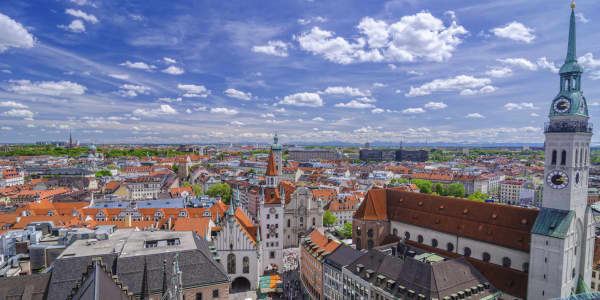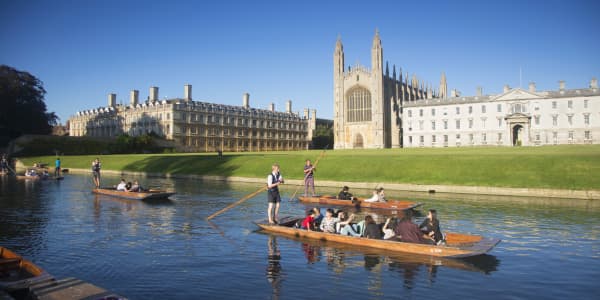10 awesome, innovative skyscrapers
If a city wants to show the world its wealth, power and status, it builds a skyscraper.
And the coming decades will see even more cities across the globe competing with one another to build the tallest, most awe-inspiring skyscraper.
Some of these modern day Towers of Babel seem nothing more than a conspicuous display of wealth: completed in 2010 and standing at 2717 feet, Dubai's Burj Khalifa (pictured) cost a staggering $1.5 billion to build.
But for many other cities, tall buildings are needed to fill a shortage of affordable, innovative and sustainable housing.
Here, we feature the past 10 winners of the Emporis Skyscraper Awards. The awards, organized by Emporis, a global provider of building information, are the world's foremost for 'high-rise architecture' and recognize excellence in design and functionality.
—By Anmar Frangoul, Special to CNBC.com
Posted 8 Jan. 2014
2003: 30 St Mary Axe, London, United Kingdom
Completion date: 2003
Affectionately known to Londoners as 'the Gherkin', the Norman Foster-designed building is 179.80 meters tall and cost an estimated £138 million ($226 million) to construct.
Situated in the middle of London's bustling and cramped financial center, 30 St Mary Axe was the City's first environmentally sustainable skyscraper.
Thanks to its design and spiraling light wells, the building is rich in natural light and ventilation, reducing reliance on artificial air conditioning systems. It is also primarily fueled by the clean energy source of natural gas.
These green innovations mean that 30 St Mary Axe has a low carbon footprint and consumes half the power a similar high rise office building would.
2004: Taipei 101, Taipei, Taiwan
Completion date: 2004
The world's tallest building from 2004 to 2011, Taipei 101 stands a breath-taking 509.20 meters tall and cost $1.76 billion.
Its outdoor observation deck is one of the highest in the world, while the skyscraper's elevators are the fastest, able to travel at 1,010 meters per minute.
In 2011 Taipei 101 reached another milestone when it was awarded Leadership in Energy and Environmental Design (LEED) Platinum status, becoming the 'greenest' skyscraper in the world.
It achieved this through reductions in water and electricity usage as well as garbage production.
When office space is unoccupied, air conditioning and lighting systems automatically switch off. Today, Taipei 101 has reduced its CO2 emissions by almost 3,000 metric tonnes.
2005: HSB Turning Torso, Malmö, Sweden
Completion date: 2005
At 190 meters, the Turning Torso is Scandinavia's tallest building.
Designed by Spanish architect Santiago Calatrava and estimated to have cost $80 million, the building is made of nine separate cubes stacked on top of one another.
Its name reflects the fact that the top cube is twisted 90 degrees in relation to the ground floor.
A mixture of residential apartments, offices and conference space, the Turning Torso is visible from Copenhagen, approximately 15 miles away.
It's green, too. Supplied with locally sourced, renewable energy, every apartment is fitted with energy consumption monitors, which enable residents to regulate their energy usage and expenditure.
2006: Hearst Tower, New York City, United States
Completion date: 2006
The Norman Foster designed headquarters for magazine publisher Hearst Corporation proudly displays its green credentials.
Standing 181.97 meters tall and built for $500 million, it became the first office building in New York to receive a Gold LEED Rating from the U.S. Green Building Council.
Ninety percent of steel used in the building's structure comes from recycled materials, while all wet food waste is composted.
Light sensors regulate the amount of artificial light used in the building while its roof collects rainwater, reducing the amount that is dumped in the city's sewage system.
2007: Het Strijkijzer, The Hague, Netherlands
Completion date: 2007
Occupying a tiny plot of just 30x35 meters in The Hague, Het Strijkijzer – which translates as "the iron" – is 131.58 meters tall. Its distinctive design is inspired by New York City's iconic Flatiron Building.
Primarily a residential skyscraper, it contains 300 affordable studios for students and young people, as well as 48 luxury apartments which start at 990 euros ($1346) per month, excluding bills. The building also houses 12 short stay apartments, at a cost of 1,132 euros ($1540) per month.
The building is fitted with a range of innovative technology. Residents use swipe cards to access the building and apartments, while there is a mail delivery system based on a paternoster – linked compartments moving continuously on a belt. Residents key in their code, and their mail box appears in a wall.
2008: Mode Gakuen Cocoon Tower, Tokyo, Japan
Completion date: 2008
The Mode Gakuen Cocoon Tower is a vertical, self-contained alternative to the world's sprawling university campuses.
Situated in the Nishi-Shinjuku district of Tokyo – where space is at an absolute premium – the 204 meter tall tower houses three vocational schools and can hold roughly 10,000 students over 50 storeys.
The second tallest educational building in the world, after the Main Building of Moscow University in Russia, the Mode Gakuen Cocoon Tower has a series of innovative features.
A "cogeneration system" generates both electrical and thermal power and creates roughly 40 percent of the tower's energy, according to the Council on Tall Buildings and Urban Habitat. This helps to reduce carbon emissions.
Its curved design is intended to represent a 'cocoon' that will incubate, teach and transform students.
2009: Aqua, Chicago, United States
Completion date: 2009
Its facade resembling an uneven rock formation surrounded by water, Aqua is almost 250 meters tall and is reported to have cost $475 million.
A mixed use residential development in the city's Lakeshore East area, it is home to one of the largest green roofs in Chicago, at 7,000 square meters.
The plants used in the garden are all native, and help to regulate the building's temperature in both winter and summer. The green roof also improves air quality and helps reduce carbon emissions.
Aqua is bird friendly, too. In 2009 the campaign group People for the Ethical Treatment of Animals (PETA) awarded Studio Gang Architects, the practice that designed the building, a Proggy – or progress – Award.
PETA commended Aqua for its undulating curves and etched glass, which makes it easier for birds to see, lessening the likelihood of them flying into the building.
2010: Hotel Porta Fira, L'Hospitalet de Llobregat, Barcelona, Spain
Completion date: 2010
Designed by Japanese architect Toyo Ito, this striking red hotel was commended for the way in which it was able to integrate seamlessly into a dense urban environment.
Standing 113 meters tall and with an estimated cost of over 90 million euros ($122.5 million), the hotel is packed with technology, including energy saving systems, solar power and a system for collecting and reusing water.
And if you feel like staying in one of the world's most innovative, recognizable tall buildings, it won't cost you the earth: rooms start around 80 euros ($109) per night.
2011: New York by Gehry, New York City, United States
Completion date: 2011
The first skyscraper by Toronto-born architect Frank Gehry, New York by Gehry cost $875 million and stands at 265.18 meters, making it the tallest residential building in the Americas.
Located in Manhattan, the building has a distinctive, undulating stainless steel façade.
As well as offering exclusive residential apartments with stunning views, New York by Gehry also houses a public school complete with its own rooftop playground, offering an innovative solution to the pressing need for educational facilities in urban environments.
2012: Absolute World Towers, Mississauga, Canada
Completion date: 2012
Located in Mississauga, a city just outside of Toronto, Absolute World Towers 1 and 2 have become instantly recognizable thanks to their height – 176 and 158 meters tall respectively -- and shape.
Primarily used for residential purposes, their revolutionary, curvy shape has seen them nicknamed the 'Marilyn Monroe Towers'. In total, it cost 450 million Canadian dollars to complete the five tower Absolute World project.
No two floors in the towers have the same dimensions, with each one twisting up to eight degrees more than the previous.




